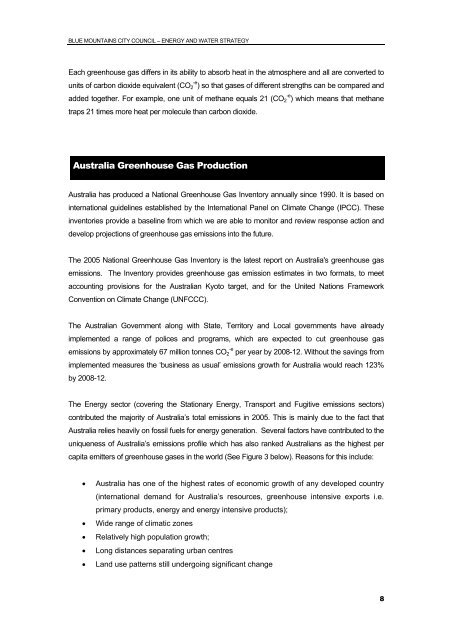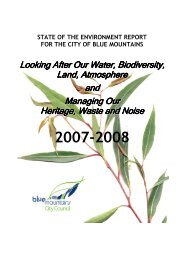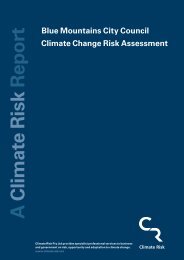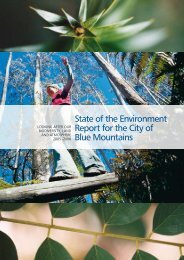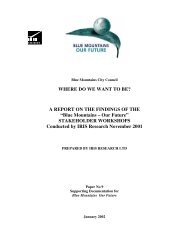Energy and Water Strategy 2007-2010 - Sustainable Blue Mountains
Energy and Water Strategy 2007-2010 - Sustainable Blue Mountains
Energy and Water Strategy 2007-2010 - Sustainable Blue Mountains
You also want an ePaper? Increase the reach of your titles
YUMPU automatically turns print PDFs into web optimized ePapers that Google loves.
BLUE MOUNTAINS CITY COUNCIL – ENERGY AND WATER STRATEGY<br />
Each greenhouse gas differs in its ability to absorb heat in the atmosphere <strong>and</strong> all are converted to<br />
units of carbon dioxide equivalent (CO -e 2 ) so that gases of different strengths can be compared <strong>and</strong><br />
added together. For example, one unit of methane equals 21 (CO -e 2 ) which means that methane<br />
traps 21 times more heat per molecule than carbon dioxide.<br />
Australia Greenhouse Gas Production<br />
Australia has produced a National Greenhouse Gas Inventory annually since 1990. It is based on<br />
international guidelines established by the International Panel on Climate Change (IPCC). These<br />
inventories provide a baseline from which we are able to monitor <strong>and</strong> review response action <strong>and</strong><br />
develop projections of greenhouse gas emissions into the future.<br />
The 2005 National Greenhouse Gas Inventory is the latest report on Australia's greenhouse gas<br />
emissions. The Inventory provides greenhouse gas emission estimates in two formats, to meet<br />
accounting provisions for the Australian Kyoto target, <strong>and</strong> for the United Nations Framework<br />
Convention on Climate Change (UNFCCC).<br />
The Australian Government along with State, Territory <strong>and</strong> Local governments have already<br />
implemented a range of polices <strong>and</strong> programs, which are expected to cut greenhouse gas<br />
emissions by approximately 67 million tonnes CO -e 2 per year by 2008-12. Without the savings from<br />
implemented measures the ‘business as usual’ emissions growth for Australia would reach 123%<br />
by 2008-12.<br />
The <strong>Energy</strong> sector (covering the Stationary <strong>Energy</strong>, Transport <strong>and</strong> Fugitive emissions sectors)<br />
contributed the majority of Australia’s total emissions in 2005. This is mainly due to the fact that<br />
Australia relies heavily on fossil fuels for energy generation. Several factors have contributed to the<br />
uniqueness of Australia’s emissions profile which has also ranked Australians as the highest per<br />
capita emitters of greenhouse gases in the world (See Figure 3 below). Reasons for this include:<br />
• Australia has one of the highest rates of economic growth of any developed country<br />
(international dem<strong>and</strong> for Australia’s resources, greenhouse intensive exports i.e.<br />
primary products, energy <strong>and</strong> energy intensive products);<br />
• Wide range of climatic zones<br />
• Relatively high population growth;<br />
• Long distances separating urban centres<br />
• L<strong>and</strong> use patterns still undergoing significant change<br />
8


